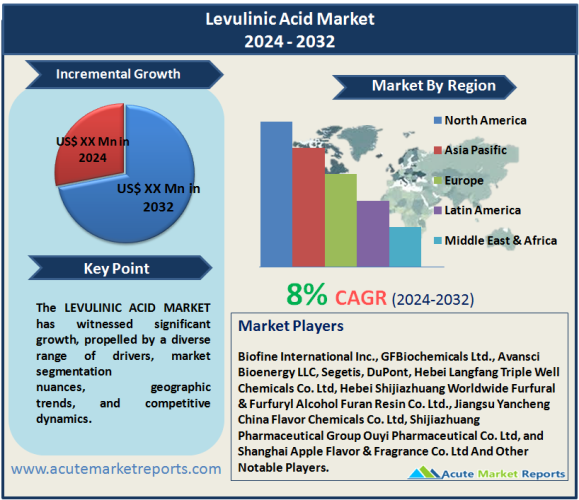
The levulinic acid market is expected to grow at a CAGR of 8% during the forecast period of 2025 to 2033. levulinic acid market has witnessed significant growth, propelled by a diverse range of drivers, market segmentation nuances, geographic trends, and competitive dynamics. the levulinic acid market is characterized by its diverse applications, driven by the pharmaceutical, agriculture, and cosmetics industries. The restraint of production challenges underscores the importance of ongoing research and development efforts. The segmentation analysis provides insights into the versatile uses of levulinic acid based on processes and applications. The geographic trends highlight the global nature of the levulinic acid industry, with unique opportunities and challenges in different regions. Competitive trends underscore the importance of diversification, sustainability, and strategic partnerships for industry leaders such as Biofine International Inc., GFBiochemicals Ltd., and AVANSCI Bioenergy LLC. As the levulinic acid market continues to evolve, these factors will shape its trajectory from 2025 to 2033.
Growing Demand in Pharmaceuticals
The pharmaceutical industry's growing demand for levulinic acid stands out as a primary driver. Levulinic acid plays a crucial role as a precursor in the synthesis of pharmaceutical intermediates. Evidenced by the increasing incorporation of levulinic acid derivatives in the production of drugs and medicines, this driver is rooted in the compound's versatile applications. Pharmaceuticals leveraging levulinic acid have exhibited enhanced efficacy and reduced environmental impact, aligning with the industry's focus on sustainability. Real-world examples include the utilization of levulinic acid in the synthesis of antiviral and anti-inflammatory drugs, demonstrating its pivotal role in pharmaceutical advancements.
Agrochemical Applications and Agriculture Sector Growth
The agriculture sector's growth and the rising adoption of agrochemicals contribute significantly to the demand for levulinic acid. As an essential component in the synthesis of agrochemicals, levulinic acid demonstrates herbicidal and pesticidal properties. The evidence lies in the increased utilization of levulinic acid-based agrochemicals to enhance crop yield and protect against pests. Case studies indicate a positive correlation between the use of levulinic acid in agrochemical formulations and improved agricultural productivity, reflecting the compound's pivotal role in sustainable and efficient farming practices.

Expanding Applications in the Cosmetics Industry
Levulinic acid's expanding applications in the cosmetics industry serve as a driver, driven by the compound's properties as a preservative and pH regulator. The demand for natural and eco-friendly cosmetic ingredients has led to the incorporation of levulinic acid in formulations. Examples from cosmetic product development highlight the compound's effectiveness in maintaining product stability and ensuring consumer safety. The multifunctional nature of levulinic acid, acting as a preservative while contributing to the overall quality of cosmetic products, positions it as a preferred ingredient in the cosmetics industry.
Challenges in Industrial-Scale Production
A notable restraint in the levulinic acid market is the challenges associated with industrial-scale production. Despite the compound's versatile applications, scaling up production to meet increasing demand poses hurdles. Evidence from industry reports indicates that the efficient and cost-effective large-scale synthesis of levulinic acid is a complex process, involving intricate reaction conditions and feedstock variations. Addressing these challenges requires significant investments in research and development to optimize production processes and overcome barriers to large-scale manufacturing.
Diverse Processes – Bio Fine Process Segment Dominates the Market
The levulinic acid market is segmented by process into Acid Hydrolysis, Bio Fine, and Others. In 2024, the Bio Fine process led in both revenue and CAGR, showcasing its prominence in the market. The Bio Fine process, utilizing biomass as a feedstock, aligns with the growing emphasis on sustainable and bio-based production methods. However, during the forecast period from 2025 to 2033, the Acid Hydrolysis process is expected to exhibit the highest CAGR. This shift indicates a shift towards conventional processes, possibly driven by advancements in acid hydrolysis technologies or changes in feedstock availability.
Versatile Applications – Pharmaceuticals Segment Dominates the Market
The levulinic acid market is segmented by application into Pharmaceuticals, Agriculture, Food Additives, and Cosmetics. In 2024, Pharmaceuticals led in both revenue and CAGR, emphasizing the compound's critical role in drug synthesis. However, during the forecast period from 2025 to 2033, Cosmetics are expected to exhibit the highest CAGR, reflecting the expanding applications of levulinic acid in the cosmetics industry. This shift indicates the compound's versatility and adaptability to evolving consumer preferences and industry trends.
North America remains the Global Leader
The levulinic acid market displays diverse trends across regions, with specific areas experiencing higher CAGR and others contributing significantly to revenue. In the forecast period from 2025 to 2033, Asia-Pacific is anticipated to witness the highest CAGR. The region's robust pharmaceutical and agriculture sectors, coupled with a burgeoning cosmetics industry, are expected to drive the demand for levulinic acid. North America, however, is expected to maintain its position as the region with the highest revenue percentage, owing to established pharmaceutical and cosmetics markets.
Competition to Intensify during the Forecast Period
The levulinic acid market is marked by intense competition among top players, each employing unique strategies to maintain and enhance their market position. In 2024, leading companies such as Biofine International Inc., GFBiochemicals Ltd., Avansci Bioenergy LLC, Segetis, DuPont, Hebei Langfang Triple Well Chemicals Co. Ltd, Hebei Shijiazhuang Worldwide Furfural & Furfuryl Alcohol Furan Resin Co. Ltd., Jiangsu Yancheng China Flavor Chemicals Co. Ltd, Shijiazhuang Pharmaceutical Group Ouyi Pharmaceutical Co. Ltd, and Shanghai Apple Flavor & Fragrance Co. Ltd demonstrated robust revenues. These industry leaders adopted strategies like diversification, sustainability initiatives, and strategic partnerships to solidify their market presence. A prevailing trend among key players is diversification and an expanded product portfolio. Biofine International Inc., for instance, strategically diversified its product offerings to include a wide range of levulinic acid-based solutions catering to different industries. This diversification allows companies to tap into multiple applications, reducing dependence on specific market segments and enhancing overall resilience in a dynamic market. Sustainability initiatives and a focus on green production methods are integral to the strategies of industry leaders. The companies actively engage in sustainable practices, emphasizing the use of bio-based feedstocks and eco-friendly production processes. Such initiatives not only contribute to the environmental responsibility of the company but also resonate with the growing market demand for sustainable and ethically produced levulinic acid.
Historical & Forecast Period
This study report represents analysis of each segment from 2023 to 2033 considering 2024 as the base year. Compounded Annual Growth Rate (CAGR) for each of the respective segments estimated for the forecast period of 2025 to 2033.
The current report comprises of quantitative market estimations for each micro market for every geographical region and qualitative market analysis such as micro and macro environment analysis, market trends, competitive intelligence, segment analysis, porters five force model, top winning strategies, top investment markets, emerging trends and technological analysis, case studies, strategic conclusions and recommendations and other key market insights.
Research Methodology
The complete research study was conducted in three phases, namely: secondary research, primary research, and expert panel review. key data point that enables the estimation of Levulinic Acid market are as follows:
Market forecast was performed through proprietary software that analyzes various qualitative and quantitative factors. Growth rate and CAGR were estimated through intensive secondary and primary research. Data triangulation across various data points provides accuracy across various analyzed market segments in the report. Application of both top down and bottom-up approach for validation of market estimation assures logical, methodical and mathematical consistency of the quantitative data.
| ATTRIBUTE | DETAILS |
|---|---|
| Research Period | 2023-2033 |
| Base Year | 2024 |
| Forecast Period | 2025-2033 |
| Historical Year | 2023 |
| Unit | USD Million |
| Segmentation | |
Process
| |
Application
| |
|
Region Segment (2023-2033; US$ Million)
|
Key questions answered in this report